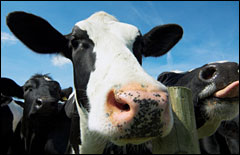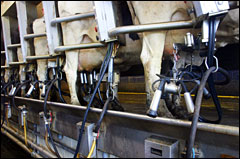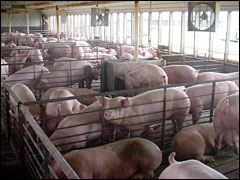Two years ago, dairy giant Dean Foods shuttered a milk-processing facility in Wilkesboro, a town at the eastern edge of North Carolina’s Appalachian Mountains.

Photo: iStockphoto
Dean processes 35 percent of the fluid milk in the U.S. and Canada — roughly equal to the combined market share of its three biggest rivals combined. In my area of western North Carolina, it processes 100 percent of the fluid milk. Since there were no other USDA-approved processing plants around, the few remaining dairy farmers in the mountains faced a stark choice: pay to have their milk hauled an additional 55 miles to Winston-Salem, where Dean ran another plant, or exit the business.
In the tiny mountain town of Bethel, N.C. — 45 miles west of Wilkesboro — one such farmer took the second option, closing a 50-cow operation he had started in 1959. When he started his farm, Bethel had around a dozen dairy farms. Today it has none.
When I think of consolidation in the food industry — fewer and fewer companies controlling more and more production — I think of that small farm in Bethel.
Squeezed to the Last Drop
In many ways, the farm embodied what we think of as sustainable agriculture: The cows there fed on ample, lush pasture in the temperate months, and hay and corn grown on the farm in winter. The farmer rejected growth hormones, and used antibiotics only on sick animals, not as a prophylactic. And rather than letting manure fester in a lagoon, he spread it back on the pasture, fertilizing the next season’s grass and feed crops.
And the farm enjoyed broad support within the community. I was among the ranks of people, probably four or five per day, who would show up at the milk house in the afternoon with empty jugs to buy rich, raw milk — delicious on its own, but even more wonderful in coffee or transformed into yogurt and cheese.
We did so illicitly. Under North Carolina law, unpasteurized milk can only be sold to consumers as animal feed; that’s why I’m withholding the farmer’s name. He charged us twice what he got per gallon from the processor, and we would have paid more.

Milking ain’t what it used to be.
Photo: iStockphoto
Our support provided a nice income stream, but not enough to pay his bills. As in most localities throughout the U.S., demand for local, delicious, responsibly grown food is growing briskly in western North Carolina. Yet only a limited number of people are willing to drive out of their way, bring their own containers, ignore hysterical warnings against raw milk, and defy the law just to support a local dairy. The path of least resistance leads to the supermarket.
So the farmer still relied on Dean Foods for a steady paycheck. He still needed to have his milk trucked away to a facility run by the nation’s largest dairy processor, where it would be mixed indiscriminately with milk from much larger, less pasture-based farms, pasteurized, homogenized, bottled, and sent to supermarkets throughout the Southeast.
To market their milk, farmers, not the processor, pay the trucking costs. When the Wilkesboro facility closed, farmers suddenly had to bankroll a trip more than twice as long as before. Around the same time, gas prices were surging, meaning that the farmer not only had to pay for 55 additional miles, but each mile became more expensive, making the operation no longer profitable.
We had growing demand for local, sustainably produced milk and a farmer willing to supply it, but what could have been a thriving enterprise plunged into an abyss.
The Huge Get Bigger
The conditions faced by the Bethel dairy farmer prevail through most of the United States. Like most of the orange juice it produces, the U.S. food system is highly concentrated. The latest study [PDF] from University of Missouri researchers Mary Hendrickson and William Heffernan — who track market consolidation among food companies — provides stark evidence.
By 2005, just four companies (Tyson, Cargill, Swift & Co., and National Beef Packing) were slaughtering 83.5 percent of cows. That number has inched up from 81 percent in 2000. In hogs and chicken, the big are getting bigger even faster. In 2001, the top four companies (Smithfield, Tyson, Swift & Co., and Cargill) killed 59 percent of hogs. By 2005, that number had risen to 64 percent. For chickens, just two companies — Tyson and Pilgrim’s Pride — kill 47 percent of birds. The top four companies control 58.5 percent of the market, up from 50 percent in 2000.
As these few companies engulf market share, they gain increasing power to dictate terms to growers. In meat processing, the companies wield a second weapon: captive herds. Smithfield, for example, is not only the nation’s dominant hog processor. In addition to slaughtering 27 million hogs per year, the behemoth also raises 1.2 million hogs of its own — more than any other operation by a factor of three. It also controls a huge portion of the hogs it slaughters indirectly, through contracts with large-scale growers.

A captive audience.
Photo: USGS.gov
Pork giants Tyson and Cargill also keep large captive herds, and buy most of the rest of the hogs they slaughter under contract. They use their market might to squeeze prices, giving small, independent growers two options. They can get bigger, in hopes of making up in volume what they’re losing in price; or they can shut down. The result has been a nearly wholesale obliteration of small hog farms, and an explosion in the size and geographical concentration of operations.
Iowa, the nation’s leading hog-producing state, tells the story. The state’s pork producer’s association informs us that the total number of hog farms plunged from more than 59,000 in 1978 to around 10,000 in 2002, an 83 percent drop. Over the same time span, the total number of hogs raised per year jumped from 19.9 million to 26.7 million. That means the average number of pigs per farm soared from 250 to more than 1,500. And production, which had been broadly distributed across the state, shifted to just a few counties. North Carolina, the nation’s No. 2 hog state, shows similar trends.
Conventional vegetable farmers, too, face tightly consolidated markets. Power to influence vegetable prices rests with a few large middlemen selling to huge buyers like supermarkets and fast-food chains. Just five companies, led by Wal-Mart, control nearly half of U.S. supermarket sales. Because of the regionally fragmented nature of the industry, that number understates the situation. In any given region, three or four supermarket chains typically dominate sales, with Wal-Mart typically taking the No. 2 or No. 3 spot. Nationwide, Wal-Mart rang up nearly $100 billion in grocery sales last year, up 48.6 percent since 2004. That’s more sales than its two closest rivals, Kroger and Albertson’s, combined.
If you’re a farmer with, say, 100 acres of tomatoes in Florida, you take the price the big buyers are offering, or watch your crop wither as buyers look south to Mexico for a willing seller.
The Not-So-Free Market
How did a few corporations gain such dominance over food production and retailing? One response is: people want cheap food, and the market gave it to them. If low cost is the main goal of food production, consolidation makes sense. Big operations gain economies of scale. You can’t argue with the results — the U.S. has the world’s cheapest food as a percentage of income.
But that reasoning is naïve. Agricultural markets don’t operate freely; they’re manipulated as a matter of course. The government subsidizes corn and soybean production, allowing farmers to sell at prices that don’t even offset production costs. And taking animals off of pasture and confining them in cages — the dominant production mode for our meat, dairy, and eggs — only works if there’s a cascade of cheap corn and soybeans to feed them.
Moreover, as feedlot and slaughterhouse interests gained economic might, they also began to wield extraordinary political leverage. Local and state governments have been notoriously lax in forcing feedlot operations to clean up their considerable environmental messes. Authorities have also historically looked away from the industry’s brazen violations of labor code. The ability to abuse the environment and labor with near impunity acts as a de facto subsidy, allowing industry giants to keep costs down as they gobble market share.
After 50 years of such trends, merely ending feed-crop subsidies and forcing agribusiness giants to clean up their messes won’t rebuild more benign food-production networks. Throughout most of the nation, local-food infrastructure has withered away, and the few remaining small farmers aren’t making enough spare cash to make the necessary investments.
Over on Gristmill, I’ll look at how we might redress the situation in the 2007 farm bill, currently under debate in Congress.

